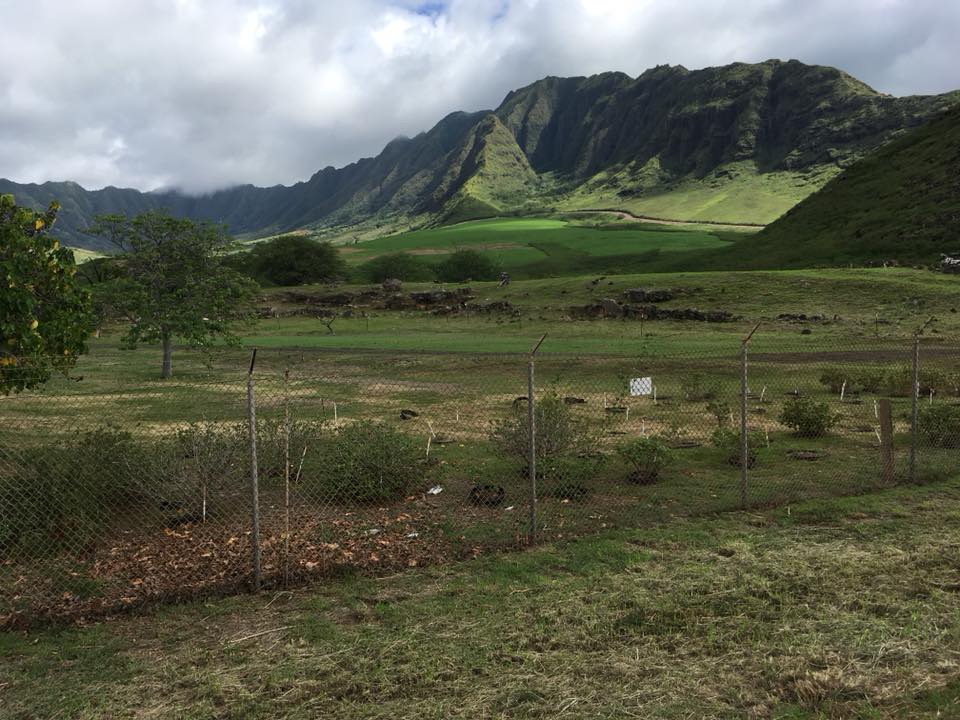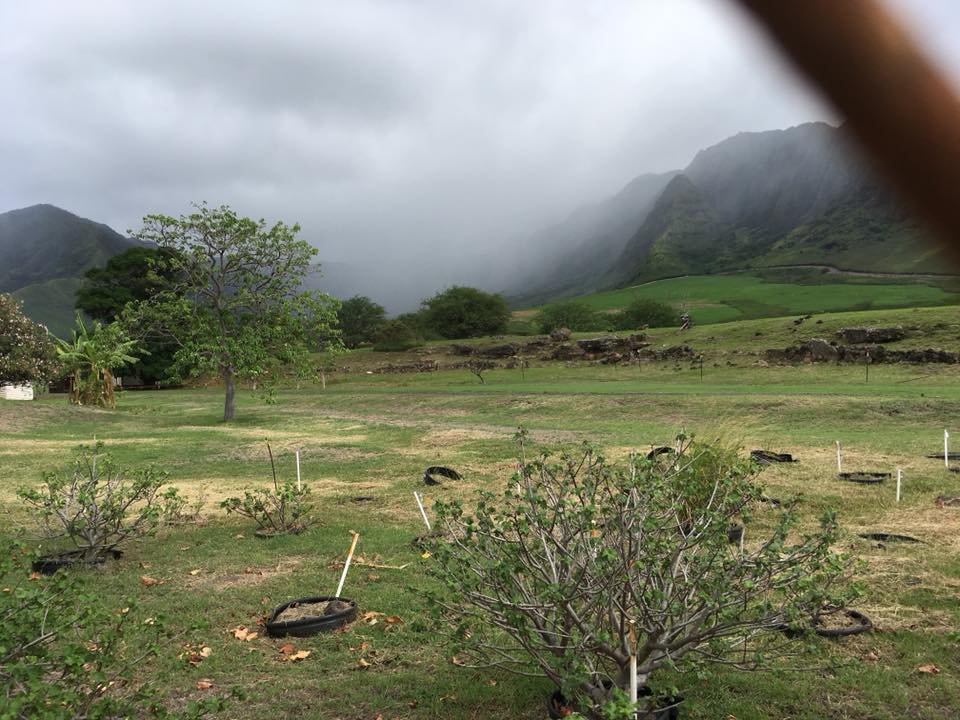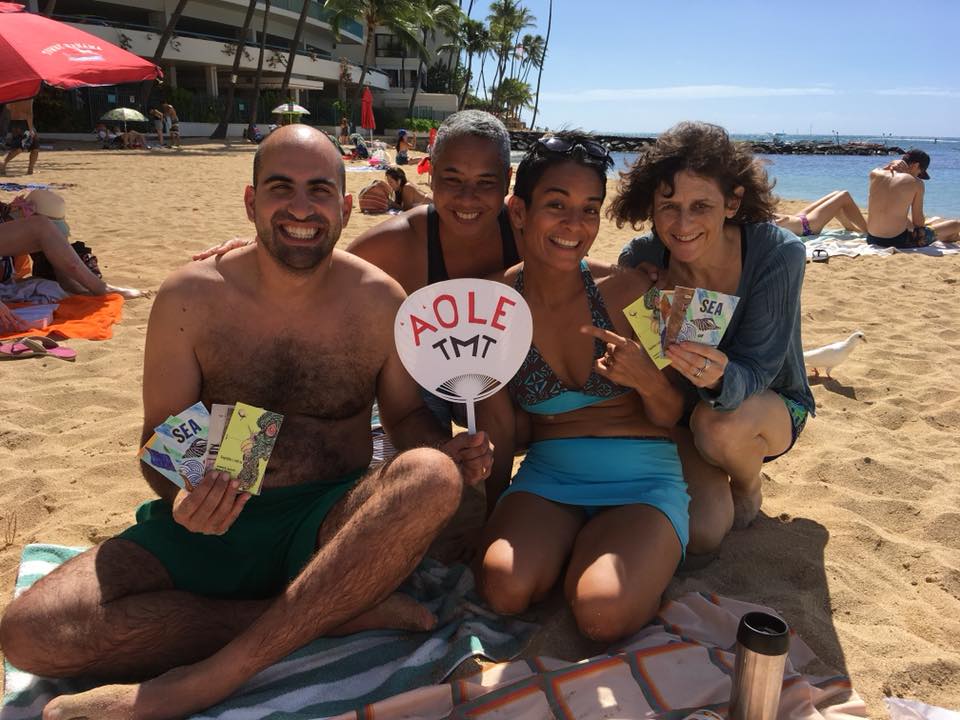I didn’t think it would be like The Brady Bunch—brown women with bare midriffs and grass skirts offering leis as we stepped onto a sunny tarmac—and yet I can’t say I expected Animal House, either. But that’s exactly what I got on my United flight from San Francisco to Honolulu, an economy-class atrocity filled with sun-starved tourists (guessing by their accents) from the upper Midwest.
The scent of cheap liquor and coconut sunscreen suffused the fuselage. People in short sleeve button-ups patterned with safari hats and palm fronds shouted obscenities up and down the aisles. They continued hooting and yapping long after it was time for any reasonable person to have slept. Cognizant of what happens to unruly Arabs on airplanes, I conducted a silent protest by swallowing an Ambien.
As I began to doze, I remembered that journeys to Tel Aviv are notorious for rude passengers. Shitty inbound flights appear to be a standard feature of visiting places suffering military occupation.
*****

The Makua military reservation in Oahu
I heard the line more than once in advance of my trip to Hawaii: “It’s like another country.” It’s almost an accurate observation. Hawaii is another country.
The islands, once discrete chiefdoms sharing linguistic, cultural, and political affinities, unified in the late-18th century and entered into a trade alliance with Great Britain (the union jack still adorns Hawaii’s state flag), under the watchful eye of a covetous United States. In 1893, facing pressure from the American business community, two Marine battalions overthrew Queen Lili’uokalani, putting the kingdom under US military rule, a status it maintained until becoming the 50th state in 1959. The US government formally apologized for the coup a century later, but offered no plan for restoring Hawaii to Indigenous rule.
Americans don’t think of Hawaii as occupied territory. (Too many of them don’t think about occupied territory at all.) If you’re drunk, off of either patriotism or generic liquor, I suppose it can be difficult to spot. The heavy military presence on the islands is obvious, but decent citizens are trained to view it is an expression of Hawaii’s freedom, not its subjugation. Americans can’t even watch their favorite sport without seeing “Salute To Service” festooned on the end zones. The country’s independence of spirit has always produced this sort of ritual groveling. The military is more likely than God to provoke charges of blasphemy.
The military presence in Hawaii enabled more efficient conquest of the Philippines, Korea, Indochina, and various Pacific nations. Installing bases throughout the state has not only allowed the US to better manage its East Asian interests, but also to control the vast topography of the Pacific. Hawaii itself has been a fruitful site of extraction, particularly the cash crops of pineapple, banana, coffee, and sugar.
One glaring imposition is the Makua military reservation in Oahu, some forty miles west of Honolulu. Nestled between volcanic outcrops and crystalline beaches, the reservation occupies verdant land that the Kanaka Maoli (Native Hawaiians), along with the rest of the civilian population, cannot access. Each Hawaiian island is small, including the eponymous “big island,” an accurate descriptor only in relation to its neighbors. The proliferation of bases further restricts their size.
25 percent of Oahu, for example, is controlled by the military, a figure that doesn’t include housing and sites of recreation. This enormous loss of land impedes agricultural development (Hawaii, boasting a tropical climate, imports 85 percent of its produce). It also drives up housing costs, a contributing factor to a serious homelessness problem (or “houselessness,” as locals call it).
The occupation of Hawaii is evident throughout Oahu’s suburban landscape. The area around Pu’uloa (Pearl Harbor) hosts neat little subdivisions of duplexes and semitropical tract houses surrounded by ubiquitous chain-link fences. In the middle of it all is a Navy-issue golf course, a monstrosity of land usage with reserved parking for the head of the Pacific Command.

Incoming rainstorm at Makua
I stood outside Makua with a group of friends and watched through a barricade of crisscrossed steel as a rainstorm gathered. The clouds, tumbling leeward in a bone-white haze, hugged the sharp façade of the mountains, the edges of their downburst sprinkling our faces. For years, fighter jets lobbed bombs into the valley, but from our vantage point only the germination of life was visible.
I’ve never seen anything so spectacular. And in Hawaii’s nonstop contrast between lushness and sparsity, I’ve never seen anything so spectacularly discordant.
*****
I visited Hawaii in large part to learn more about Kanaka Maoli resistance and to converse with local activists and intellectuals about Palestine. There’s a lot to compare, and a lot to gain from making comparisons. However, we ought to be careful not to strip national communities of their distinctiveness. Useful comparison finds a way to enlarge rather than restrict a people’s existence.
Here are some of the notable differences between Hawaii and Palestine: for a significant period of time Hawaii was an independent kingdom, a type of sovereignty Palestine has never enjoyed; international law has a more comprehensive basis in Palestine, though many of its conventions apply to Hawaii; there are nearly as many Palestinian Arabs as Israeli Jews within the borders of historical Palestine, and more if we take into account surrounding countries, while the Kanaka Maoli are a distinctive minority; with sizable East Asian populations, many descended from laborers conscripted to the islands, Hawaii has a more complex ethnic composition than Palestine, which, while hosting a wide range of ethnicities, is fundamentally organized around a confessional axis; Hawaii is already a formal possession of the USA while the West Bank and Gaza Strip have not been officially annexed; and the pre-Zionist Jewish presence in Palestine is of a different nature than the early European presence in Hawaii.
These differences are important because they indicate that while Kanaka Maoli and Palestinians share a desire for liberation, their visions of a liberated polity may not cohere (in some cases, they may; the point is to allow for the possibility). Strategies and considerations will therefore diverge. Recognizing disparities isn’t a problem of communal activism; it is a necessary element of productive interchange.
Enough commonalities exist among the two nations for a shared political project: both suffer military occupation, land theft, foreign settlement, and structural racism. In fact, they contest the same colonial apparatus. This point may seem counterintuitive, but these days the United States and Israel differ only according to technicalities of nomenclature and color scheme. Collusion between the US and Israel is by now axiomatic.
People needn’t be identical to know that it is foolish to oppose one of those powers while ignoring the other.

Palestinian men sporting “deoccupy Hawaii” lanyards; with Ali Musleh
*****
An interesting commonality between Hawaii and Palestine derives from the colonial imagination. Hawaii has been presented in American society as both barbaric and utopian. Promising an escape from the stresses of industrial life, it is a mirthful place of hula skirts and campy shirts, abounding in exotic rituals, fruit plantations, and oversexualized island women, all available without leaving the country. It took their perceived defeat for Hawaiians to be portrayed as quixotic. In tenser periods, they were shown as a dark, strange race demanding subjugation.
Depending on the moment, Palestine can be a mystical land of redemption or a generic desert frontier inhabited by terrorists and religious deviants. Palestine is a never-world, easy to erase from history and yet always in conflict with the myths of the Judeo-Christian tradition. Palestine’s majority-Muslim population betrays America’s historical imagination; the natural recourse is to replace it with a people more befitting the Holy Land. Iconography that satisfies the demands of expansionism and white supremacy is deeply important to Americans.
The defeated but heroic soldiers of Masada and Pearl Harbor provide an interesting point of comparison. American and Israeli national identity stake themselves on the resilience of the underdog. They aren’t mere polities in a chaotic global order, but exalted nations destined to succeed, positioned in exception to their more ordinary peers. Even though nearly two millennia separate Masada and Pearl Harbor, they similarly fortify the notion, repeated with the intensity of an excitable cricket, that the state is an invincible organism possessed of the will to vanquish whatever savagery it randomly encounters.
Because they have been transformed into objects of American and Israeli self-regard, Hawaii and Palestine cannot accommodate colonial pragmatism. Federalism? Extended autonomy? Limited self-rule? A state minus? None of these concepts is acceptable to the task of independence; indeed, each is a euphemism for continued dispossession. The colonized don’t want diplomatic charity; they seek a new world that doesn’t confine them to a permanent state of transition.
Arguments deeming this goal unrealistic imply that Indigenous peoples should abandon their aspirations of freedom. Indigenous activism emphasizes what the capitalist imagination considers unfeasible. Listen to Hawaiians and Palestinians. They constantly attempt to conceptualize a world unbound by commonsensical notions of the possible.
*****
My visit to Hawaii coincided with an appearance by Donald Trump. While I was learning about water, an engine of colonization, and taro, the islands’ staple crop, Trump was creating traffic nightmares in Honolulu. I wasn’t mad at him, though. His presence siphoned off the alt-right loudmouths who sometimes turn up at university events. I was a less interesting source of protest than Trump’s protesters.
Trump makes it easier to understand why Indigenous peoples don’t appreciate American rule. No rational person wants to be led by an avowed sexual predator whose go-to strategy is whipping up racial animus. Yet Trump has a way of absorbing problems infinitely larger than himself. He’s a disembodied buffoon onto whom deeper anxieties can be projected.
Put more plainly, Trump is the result of colonization, not of democracy-gone-awry. The “democracy” he inherited is working as it should, by subsidizing crooks and billionaires at the expense of communal well-being. If we delink wealth from intelligence, then it’s easy to see that a leader of Trump’s doltishness isn’t an aberration. (Binyamin Netanyahu makes a fine comparison.) Of all the things he’s made to symbolize, it’s the rotten possibilities of capitalism that ring most accurate.
Colonized peoples often become targets of liberal rage during electoral spectacles because many of their intellectuals insist on pointing out that structural problems can’t be mitigated by the ascendance of party icons. For example, it’s become a truism that any politician seeking national office in the USA must appease pro-Israel sensibilities (and thus we should forgive this flaw). Putting aside whether or not it’s true these days (I don’t think it is), the more pressing question, raised at the expense of the speaker’s reputation, is why Palestinians have to abide this kind of indignity. They’re more or less being told that they should defer freedom until the grown-ups sort out more important problems at some indeterminate point in the future. Such implications are baked into colonial governance: the native must relinquish personhood in order to access the body politic.
Advocates of decolonization certainly can, and perhaps in some cases should, participate in the civic rituals of their occupiers, but they understand that in the end neither pragmatism nor patience provides a long-term solution. An extensive body of literature in Indigenous Studies explores questions of organizing in colonized societies. These points of view are critical to both theorization and praxis in leftist spaces. Ignoring them makes it too easy to treat skepticism about the utility of Western democracy with contempt. Indigenous peoples are essential to any decent resistance, and much more radical than standard-bearing lefty pundits if we understand radicalism as a willingness to subvert ruling classes.
Not even an unwelcome presidential motorcade, its stench spritzed across the breadth of Honolulu, could diminish the fact that it required conquest, not consent, for a man like Trump to become president of Hawaii.
*****

Steven Salaita with Joy Enomoto, Kim Compoc, and Cynthia Franklin at Waikana Beach. Sign says “No TMT.”
I didn’t get to Mauna Kea, but I heard plenty about it. The huge volcano, topping out at 13,802 feet, is probably the most visible site of conflict between the Kanaka Maoli and their adversaries.
With the support of various governments and universities, NASA intends to construct the Thirty Meter Telescope [TMT] at its summit, said to be one of the best places in the world for stargazing. A technological marvel that promises great advancement in the fields of astronomy and physics, the TMT represents the biggest dream of modernity, conquering the unknown and then controlling its place in the universe.
It would also sit atop a site sacred to the Kanaka Maoli. Given that sanctity as a source of discord is a tired motif, I don’t want to downplay Mauna Kea’s significance. It is the most important mountain to Hawaiians; it also happens to be a conservation trust. Construction of the TMW would disrupt Kanaka Maoli religious practices. If this seems easy to dismiss, then consider how you might feel if a higher power decided to corrode something essential to your existence.
The Kanaka Maoli haven’t taken kindly to the TMT. The telescope’s status is currently tied up in court. Protestors have occupied both the base and summit of the mountain, shutting down construction in its early phase. Police have arrested demonstrators, but those I spoke with aren’t dissuaded by the tactic. It’s clear that even if the courts order the project forward, nothing will be easily built. Events on the ground are almost certainly livelier than whatever is happening in outer space.
Of interest is the way corporate media portray the issue, often billing it a conflict between science and superstition. (Scientists tend to use this framing, too.) But we’re better served complicating the categories, which derive from old colonial discourses. Condemning Hawaiians as anti-science doesn’t merely suggest that they are savage; it also devalues their impressive scientific legacy while absolving Western science of its role in perpetuating (or cosigning) a plethora of savagery, from brutal experimentation on human subjects (Auschwitz, Tuskegee, Abu Ghraib) to environmental devastation.
Anyway, even if we accept the ludicrously narrow terms of the binary, is any dimension of religion really more superstitious than the belief that a cosmos infiltrated by capitalism can save us from destruction?
Too many actors can’t seem to carry out a debate about Mauna Kea without reproducing ancient logic about the unsuitability of Natives for the modern world. The main problem with this logic isn’t its incorrectness (wrong to the point of silliness) or its self-regard (egotistical to the point of Donald Trump), but what it implies about the future of Indigenous peoples. If something has to go, it won’t be modernity.
Instead of rehashing age-old tropes, people might try discussing Mauna Kea beyond its tabloid features. To whom does the land belong? Who gets to control what happens there? Doesn’t sovereignty include the right to religious stewardship? Is the exploration of other worlds worth the pain we cause fellow human beings in the world we actually inhabit?
Mauna Kea is more than a fortuitous piece of real estate. It is a place of worship, a miracle of geology, a site of reflection, a call to struggle, a symbol of national autonomy. Any landscape is many things at once, but only if we view it beyond economic utility.
Mauna Kea arises in a continuous swell from the Pacific. From its base on the seafloor, it extends above 33,000 feet. To make sense of its dimensions, we measure it according to the visible part, but its primary mass is unseen and continues pushing out of the water. It brings us closer to the stars without the benefit of technology.
*****
Everybody from the hotel clerk to an NPR reporter told me about the monk seal. In late June, a mother had come ashore at Kaimana Beach to birth her new pup. Locals gave the mother, Rocky, necessary space to wean the cub, named after her birthplace, a process that lasted into early November. They soon had their own Facebook account.
Little Kaimana had skin like jet black patent leather, dusted with grains of sand and adorned by pliant whiskers. She sometimes smiled for photographers and liked to show affection, nestling with Rocky and occasionally kissing her mouth. People spoke of the seals in a reverent tone, as if cognizant of the world’s fragility. It was a moment of agreement, an existential reckoning around dark flesh on tan sand, a reemergence of wilderness in the suburbs, the contrasts offering an incisive answer to the world’s most complicated questions.
In the presence of Rocky and Kaimana, people felt secure. That sense of security didn’t arise from an abundance of bases and armaments, but from the simplicity of milk, stones, and water.
Source Article from http://mondoweiss.net/2017/11/washing-ashore-hawaii/
Related posts:
Views: 0
 RSS Feed
RSS Feed

















 November 16th, 2017
November 16th, 2017  Awake Goy
Awake Goy  Posted in
Posted in  Tags:
Tags: 
















